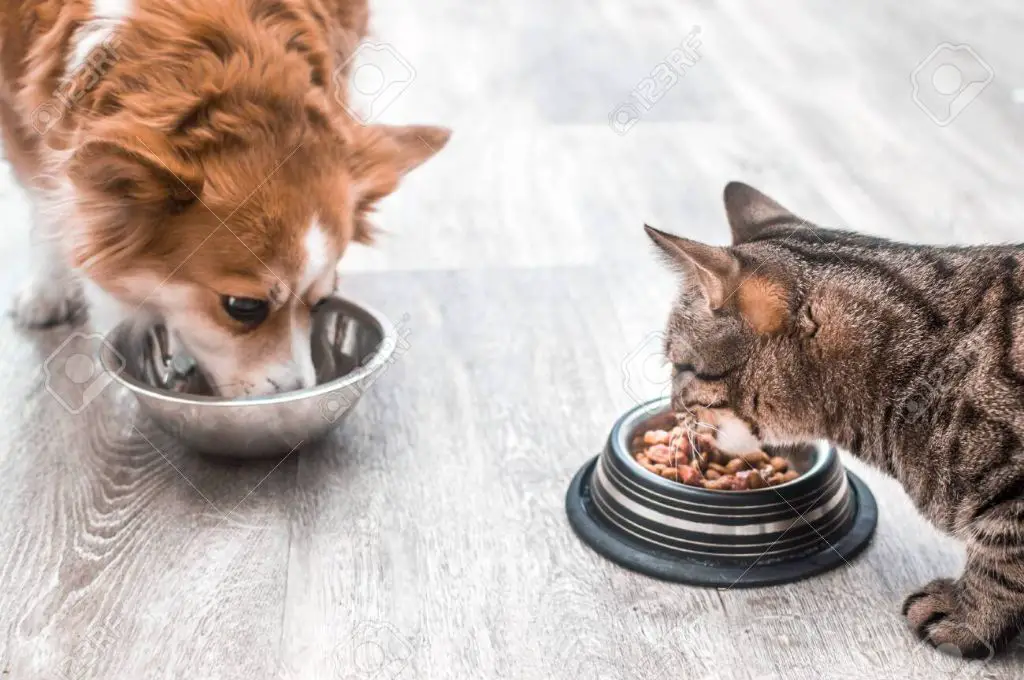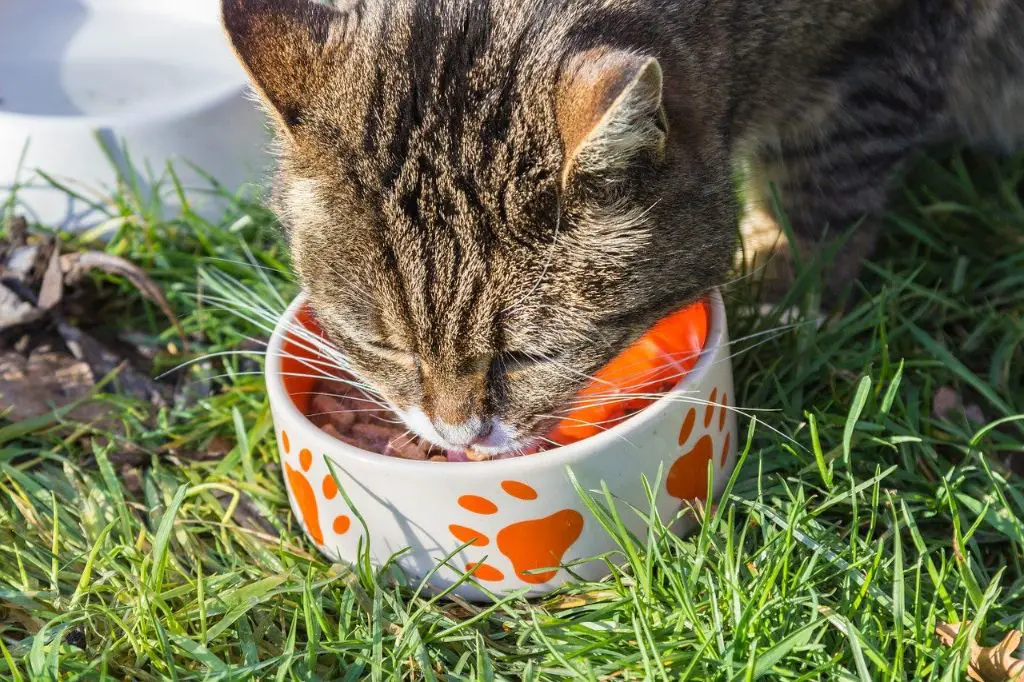It’s common for pet owners with both cats and dogs to wonder if they can feed their pets the same food. After all, it would be more convenient and likely cheaper to buy one bag of food for all your animals. However, cats and dogs have very different nutritional needs, and feeding them the same food can be dangerous.
Cats are obligate carnivores, meaning they need to eat meat to survive. Dogs, on the other hand, are omnivores and do well with a mixture of meat, grains, fruits and vegetables. Cat food is very high in protein and fat, while dog food contains more carbs and fiber.
While an occasional nibble likely won’t harm either animal, there are risks to regularly feeding cat food to dogs or vice versa. Doing so can lead to malnutrition, gastrointestinal issues, and even organ damage over time as their specific nutritional needs are not met. Consulting with your veterinarian is advised.
Nutritional Differences
Cats and dogs have very different nutritional needs. Cats are obligate carnivores, meaning they must eat meat to survive. Dogs are omnivores and can thrive on a diet with more plant-based ingredients (https://www.linkedin.com/pulse/nutritional-differences-between-cats-dogs-jonathan-cox).

Cats require higher levels of protein than dogs – at least 26% of their diet should be high-quality protein compared to just 18% for dogs. They also cannot synthesize certain essential amino acids like taurine, meaning it must come from their diet. Taurine is critical for heart health in cats. Dogs can manufacture their own taurine so don’t have this requirement (https://vetskitchen.co.uk/community/vetknowhow/the-nutritional-differences-between-cats-and-dogs-why-you-cant-feed-them-on-each-others-food).
The differences in digestibility and nutrient requirements mean cat food formulated specifically for felines provides the nutrition they need. Dog food does not have the right balance. Feeding a cat dog food long-term risks malnutrition and health problems.
Protein Content
Cats have a higher protein requirement than dogs. Cats are obligate carnivores, meaning they must consume meat to acquire certain essential amino acids not produced by their bodies. Dogs can meet their nutritional requirements with lower protein diets as they are omnivores. According to https://quizlet.com/gb/667214605/week-5-nutrition-of-the-emergency-case-flash-cards/, cats need a minimum of 6g of protein per 100 calories consumed, while dogs only require around 5g per 100 calories. Feeding a dog food that is lower in protein to a cat long-term can result in protein deficiency and associated health issues like muscle wasting and immune system problems.
Taurine
Taurine is an essential amino acid for cats, as they cannot synthesize it on their own. Cats must obtain taurine from their diet to support healthy heart, eye, and reproductive function 1. Taurine deficiency in cats can lead to dilated cardiomyopathy, vision problems, and reproductive issues.
Unlike cats, dogs have the ability to synthesize their own taurine as long as they are getting sufficient cysteine and methionine in their diet. As a result, most dog foods do not contain added taurine. However, some dog breeds, such as Golden Retrievers, have shown better health with taurine supplementation 2.
The key difference is that cats have an absolute dietary requirement for taurine, while dogs can synthesize their own but may benefit from supplementation in some cases.
Vitamins and Minerals
Cats and dogs have different vitamin and mineral needs due to differences in their metabolism and nutritional requirements.
Cats require higher levels of some vitamins than dogs, especially vitamin A and taurine. According to MeowMix, cat food tends to have higher levels of vitamins and minerals than dog food because cats cannot synthesize certain vitamins on their own 1.
One key difference is taurine. Taurine is an essential amino acid for cats that supports heart and eye health. Dogs can synthesize their own taurine so cat food provides much higher levels. Feeding dog food to cats long-term can result in taurine deficiency and heart disease 2.
Other vitamins cats need in higher amounts include vitamin A, niacin, and riboflavin. Vitamins like vitamin E and vitamin K have different minimum requirements for cats versus dogs.
Mineral differences include cats needing 2-3 times more protein and fat on a caloric basis. Calcium and phosphorus ratios also differ between cats and dogs 3. Feeding the wrong formulation can lead to imbalances.
Overall, it’s important not to substitute cat food for dog food or vice versa due to their unique vitamin and mineral profiles. A mix could easily cause a deficiency or toxicity.
Digestibility
Cats and dogs have markedly different digestive systems adapted to their natural diets. Cats are obligate carnivores, meaning they evolved to get most of their nutrients from meat and have a relatively short digestive tract optimized for digesting animal proteins and fats [1]. Dogs are omnivores and have a longer digestive tract that can better process plant matter. This means dogs can more easily digest carbohydrates, fiber and plant proteins than cats [2].

The shorter digestive tract of cats means they have a faster transit time from mouth to colon than dogs. Food passes through a cat’s gastrointestinal tract in about 12-24 hours, whereas it takes 24-72 hours in dogs. This faster transit time reduces the digestibility of nutrients in cats compared to dogs.
Allergies
Food allergies are more common in dogs than cats. According to Pumpkin (Source), approximately 10% of dogs and less than 5% of cats have food allergies. The most common allergy triggers for dogs are beef, dairy, chicken, lamb, fish, chicken eggs, and wheat (Source). For cats, the most common food allergens are beef, fish, chicken, and dairy (Source).
Symptoms of food allergies in dogs and cats can include itchy skin, ear infections, hair loss, excessive licking or chewing of paws, vomiting, and diarrhea. These symptoms typically develop slowly over time after eating the offending ingredient.
Palatability

Cats tend to be much pickier eaters than dogs. Cats have a stronger sense of smell, so they rely more heavily on aroma and flavor when choosing foods. Cat foods are designed to be more palatable to felines by having higher protein content from meat, strong aromas, and a mix of flavors. Dogs are less picky and will often eat whatever is put in front of them.1
If a cat food is unappealing to a cat, they may refuse to eat it entirely. But a dog is more likely to eat a cat food they don’t love as much. Trying to feed a cat an unpalatable dog food can lead to food avoidance. Cats require a diet specifically formulated to their preferences.
Risks
There are some risks associated with feeding your dog cat food. The most significant risk is nutritional imbalance. Cat and dog foods are formulated to meet the specific nutritional needs of each species [1]. Cats require higher levels of protein and certain amino acids like taurine. They also need more fats and fatty acids in their diet. Dogs have different protein and nutritional requirements. Feeding a dog cat food long-term can lead to protein excess and deficiencies in certain nutrients [2].

Another risk with dogs eating cat food is weight gain and obesity. Cat foods tend to be higher in fat and calories because cats have higher energy requirements than dogs of the same size. The higher calorie content of cat food can quickly lead to weight gain in dogs, especially if they eat cat food exclusively [3]. Obesity in dogs is linked to many health complications like diabetes, arthritis, heart disease, and cancer.
Conclusion
In conclusion, it’s generally not recommended to mix cat and dog food regularly. While occasional mixing in small amounts may not cause issues, their nutritional needs differ enough that they should eat diets formulated specifically for their species. Cats require higher protein and certain amino acids like taurine that dog food does not provide. They also have a higher need for various vitamins and minerals. On the flip side, too much protein and minerals from cat food can harm some dogs. Each species also digests food differently, resulting in different nutritional requirements. Regularly feeding the wrong diet can lead to malnutrition and health problems over time. Some pets may reject the taste of the other species’ food as well. While it’s fine to mix foods occasionally in a pinch, it’s best to separate feline and canine diets for their optimal health.

